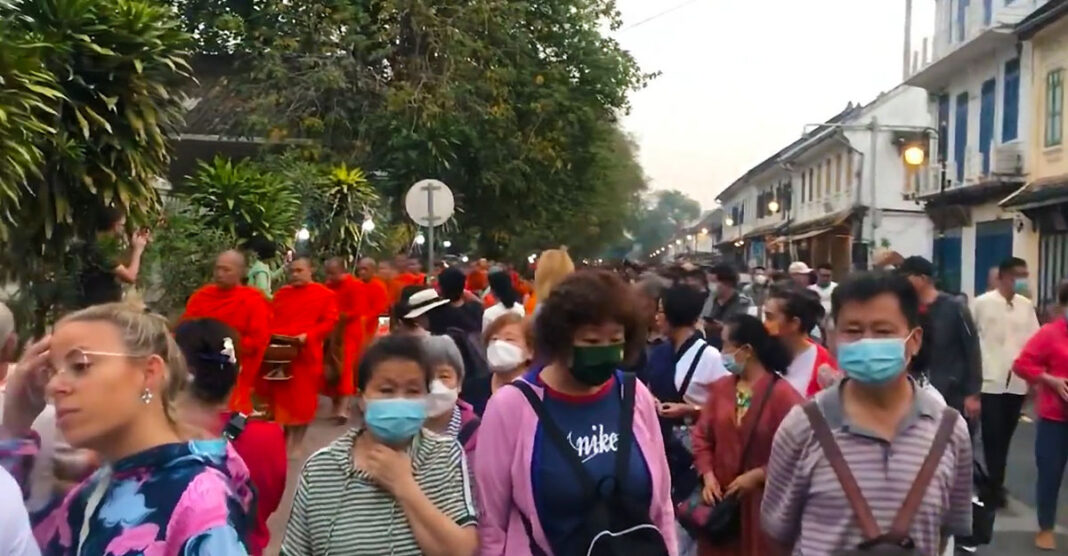Brought to its knees during the Covid-19 pandemic, Luang Prabang is now facing the opposite problem as swarms of tourists descend upon the city, with tourism experts sounding the alarm about the potential for overtourism.
The UNESCO Heritage town, which boasts a rich cultural history and stunning architecture, has seen a significant increase in tourism over the past decade. In 2019, Luang Prabang welcomed over 1.2 million tourists, with Chinese tourists accounting for nearly half of the total number of visitors.
While tourism numbers took a nosedive during the Covid-19 pandemic, they have quickly picked up in 2023, with Luang Prabang earning itself a notable mention in just about every major travel publication around the world.
The local government says Luang Prabang expects to receive 1.5 million tourists this year, and the influx of tourists has brought both economic benefits and challenges to the town. While tourism has brought much-needed revenue to local businesses and improved the standard of living for many residents, it has also placed a strain on the town’s infrastructure and resources.
One of the major concerns is the impact of overtourism on the town’s cultural heritage. The increasing number of visitors has led to overcrowding at popular attractions, while congestion by hordes of onlookers has begun to affect the morning almsgiving ritual undertaken by local people.
“As a Luang Prabang local, I’m concerned about how authorities are handling the large number of tourists visiting the city. Tour buses are causing traffic congestion, and I’m not sure that waste is being handled properly,” said Ms. Thongkhoun Soutthivilay, a resident of Luang Prabang.
“Meanwhile, some of our local cultural traditions are becoming too much of a spectacle. Tourists are not always respectful. I think we need to be more proactive in managing tourists to preserve Luang Prabang’s character,” she added.
Tourists seen crowding the morning almsgiving ceremony in #LuangPrabang, raising concerns about #overtourism. As tourism booms, it’s important to consider the impact on local communities and preserve their traditions. #overtourism #travelimpact #Laos
: Oil Virachith pic.twitter.com/urkECliVy5— The Laotian Times (@LaotianTimes) March 21, 2023
President of the Laos Hotel and Restaurant Association, Mr. Pakasith Chathapaya, said in an interview with Vientiane Times that he is concerned about what might happen when the Laos-China Railway fully opens up, allowing Chinese tourists to travel directly to Luang Prabang from Kunming.
“My concern is that our hotels and restaurants may not be able to accommodate large groups of Chinese visitors. For instance, if groups of 100-200 people arrive at a restaurant, I don’t think the restaurant could cope,” Mr. Pakasith said.
The influx of tourists has also raised concerns about the impact on the town’s cultural identity. Changing travel habits in the post-covid world have lead to new forms of tourism, with Chinese campervan enthusiasts now driving to Laos and parking their caravans along public roads.
Tour companies have also expressed concern that the large numbers of tourists, who often come in organized tour groups, are not experiencing the authentic culture of the town but rather a commercialized version of it.
“Overtourism is definitely a concern, especially as Laos has always been marketed as a quiet, authentic, and peaceful destination. It’s a worry seeing such a large number of gigantic groups… The infrastructure here isn’t ready for such massive numbers yet,” says Matt Clancy, Country Manager for Easia Travel Laos.
He says that some visitors now want to change their itineraries and skip the crowded tourist sites in favor of quieter spots.
“We have already received complaints from our European travelers that Kuang Si and Luang Prabang are too touristy. Because of these comments, some of the agencies we work with have asked us to start including longer stays outside of the main destinations.”
Tourism officials did hold meetings to discuss how to prepare for an influx of tourists after China announced its reopening, however, much of the preparations involved ensuring Chinese-speaking guides would be on hand to facilitate visitors.
Now, efforts must be made by local authorities and businesses to come up with sustainable solutions, manage visitor numbers, and limit the impact of tourism on the town’s heritage sites.
“Although overtourism is not an immediate issue, as tourists begin to flock back to Luang Prabang, the city risks losing the very charm that attracted visitors in the first place,” says Connor Bedard, SUSTOUR Laos Project Manager at Plan International Laos.
“Sustainable tourism practices, such as responsible tourism management and equitable distribution of benefits, are crucial in preserving the destination’s unique identity and ensuring its long-term viability,” he says.
The town’s future is dependent on finding a balance between preserving its cultural heritage and accommodating the needs of tourists. As tourism continues to grow in Laos, the challenges faced by Luang Prabang serve as a reminder of the importance of responsible and sustainable tourism practices.



